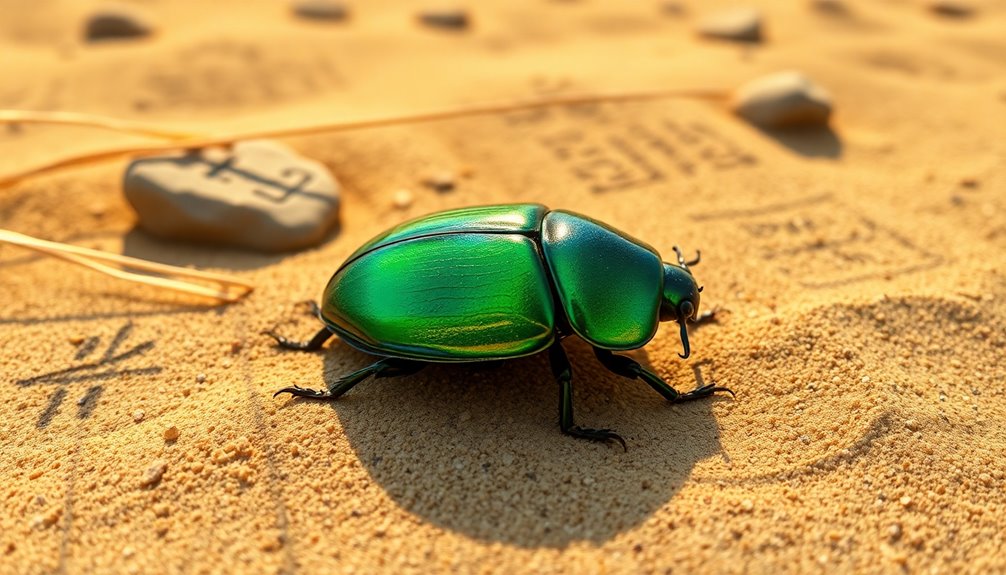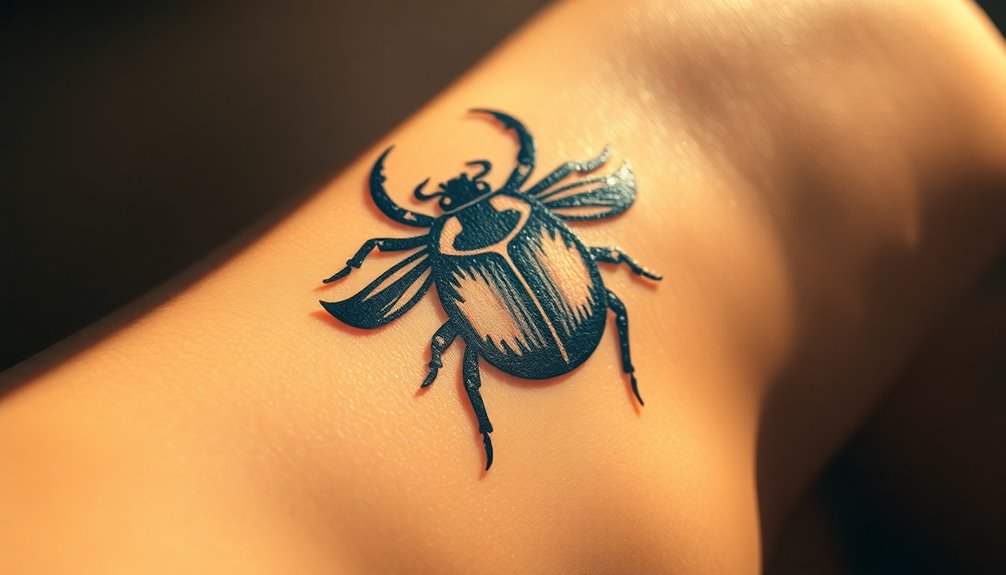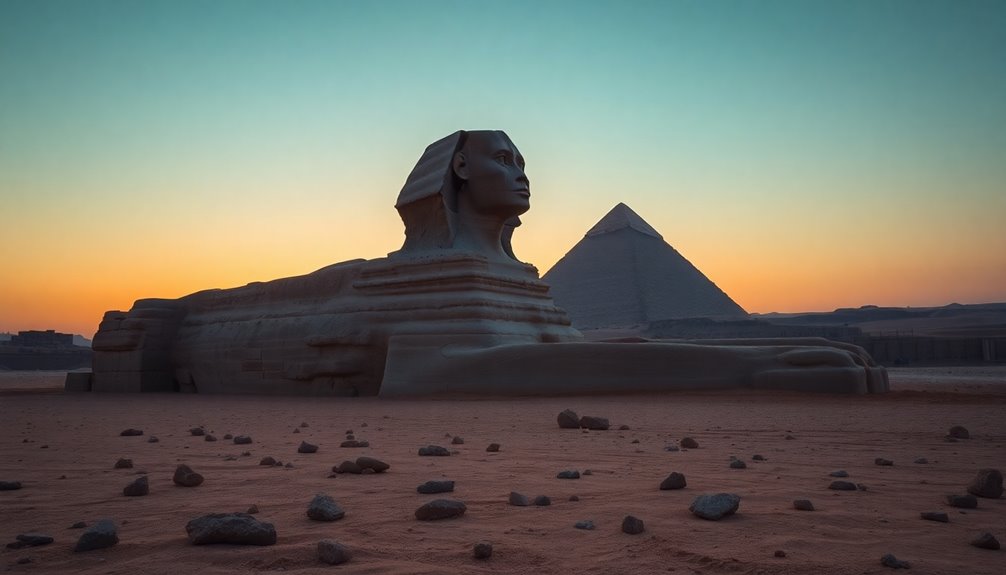The scarab beetle embodies transformation, rebirth, and protection, serving as a powerful symbol in ancient Egyptian culture. When you connect with the scarab, you tap into the energy of Khepri, the sun god, representing daily renewal and the cycles of life. This creature's journey encourages you to embrace change and see it as an opportunity for growth. Scarabs were also guardians in the afterlife, guiding souls safely and providing protection. By understanding the deeper meanings behind the scarab, you reveal ancient wisdom that can enhance your own life journey and personal evolution. More awaits you as you explore this fascinating symbolism.
Key Takeaways
- The scarab beetle symbolizes creation and renewal, reflecting the transformative journey of life and the cycles of rebirth.
- As an embodiment of Khepri, the scarab represents the sun's life force, connecting the physical and spiritual realms.
- Scarab amulets provide protection and guidance for the deceased, ensuring a safe passage into the afterlife.
- The beetle's ability to reproduce without a mate signifies immortality, reinforcing its association with eternal life and protection.
- Embracing the scarab's symbolism encourages personal growth and transformation, highlighting that endings lead to new beginnings.
Creation and Renewal Symbolism

The scarab beetle embodies powerful creation and renewal symbolism, deeply rooted in ancient Egyptian culture. This remarkable insect connects with Khepri, the god of the rising sun, representing the eternal cycle of creation and renewal.
When you observe the scarab rolling dung, you can see a reflection of Khepri's role in rolling the sun across the sky, symbolizing the natural rhythm of day and night.
The scarab's life cycle—from egg to larva, then pupa, and finally adult—highlights the themes of transformation and personal growth. You can draw inspiration from this cycle, recognizing the potential for continual renewal in your own life.
In ancient Egyptian culture, scarabs weren't just symbols; they were also amulets believed to bring good fortune and protection. They facilitated the deceased's journey to the afterlife, ensuring rebirth and a new beginning.
The Sun's Life Force
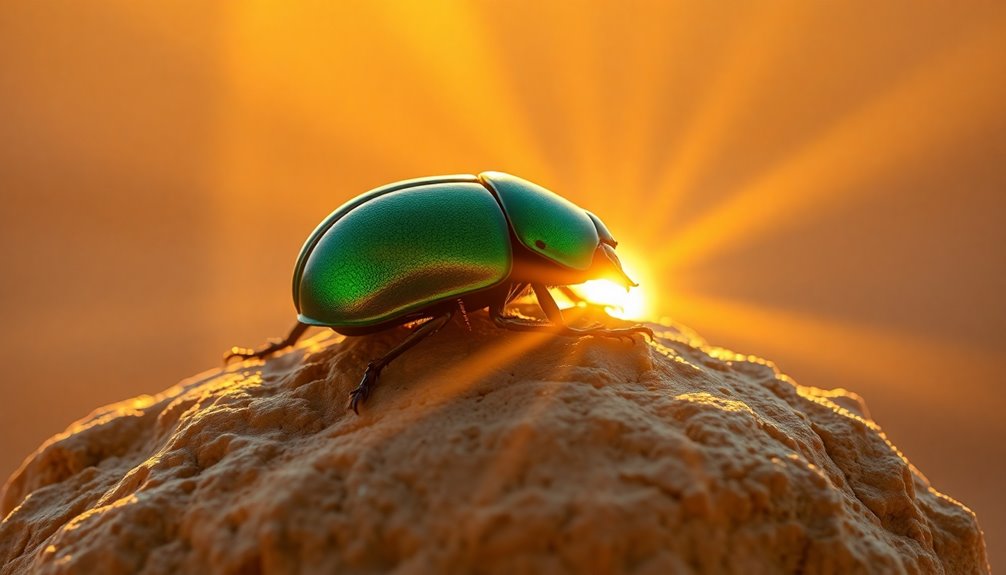
In ancient Egyptian belief, the scarab beetle serves as a powerful emblem of the sun's life force, connecting the physical world with the divine. Revered as the embodiment of Khepri, the scarab symbolizes the daily rebirth of the sun, reflecting the essential energy crucial for existence. This connection highlights the cycle of life and renewal, illustrating the transformation that occurs every day.
Imagine the scarab beetle's journey as it rolls its dung, a metaphor for Khepri rolling the sun across the sky. This cyclical motion signifies:
- The radiant sun rising each morning, igniting the world with light.
- The nourishing warmth that fuels growth and sustains life.
- The eternal dance of creation, where every ending leads to a new beginning.
Ancient Egyptians crafted scarab amulets to invoke the protective qualities of the sun, ensuring liveliness and strength for the wearer.
Guardian of the Afterlife
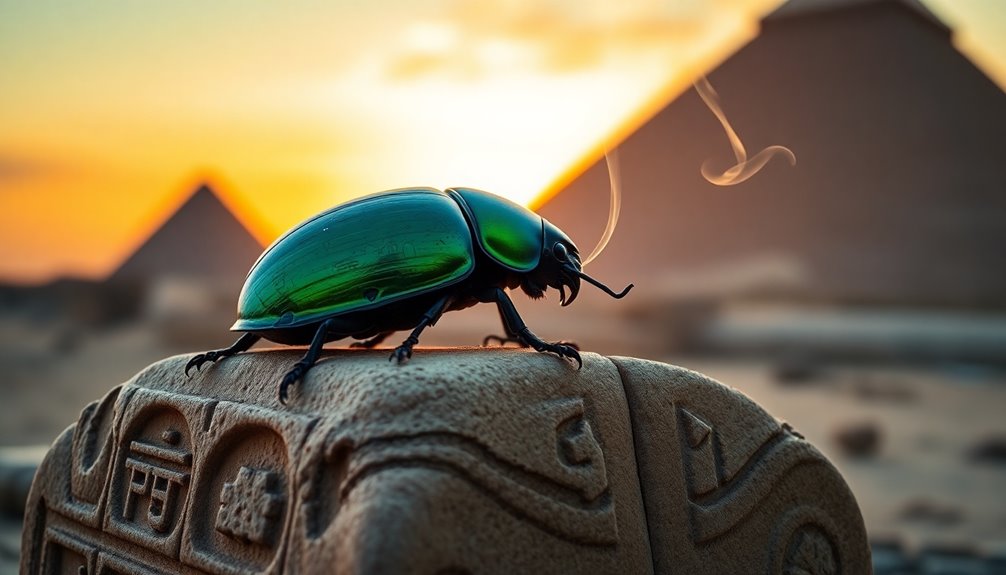
Serving as both a symbol of rebirth and a protector, the scarab beetle holds a significant role as a guardian of the afterlife in ancient Egyptian mythology.
These remarkable beetles were believed to guide the deceased through their journey after death, guaranteeing they reached the afterlife safely. The sun god Ra, who transformed into a scarab during his nightly travels, embodies the protection and navigation needed to traverse the challenges of the underworld.
Ancient Egyptians placed scarab amulets in tombs and on mummies, serving as powerful tokens of protection.
These amulets were thought to guarantee safe passage, promoting rebirth in the afterlife. Scarab beetles also held spiritual meaning connected to the heart, which was weighed against a feather during judgment to determine the deceased's fate.
This process highlighted the importance of living a virtuous life, as the outcome influenced one's eternal journey.
Immortality and Protection
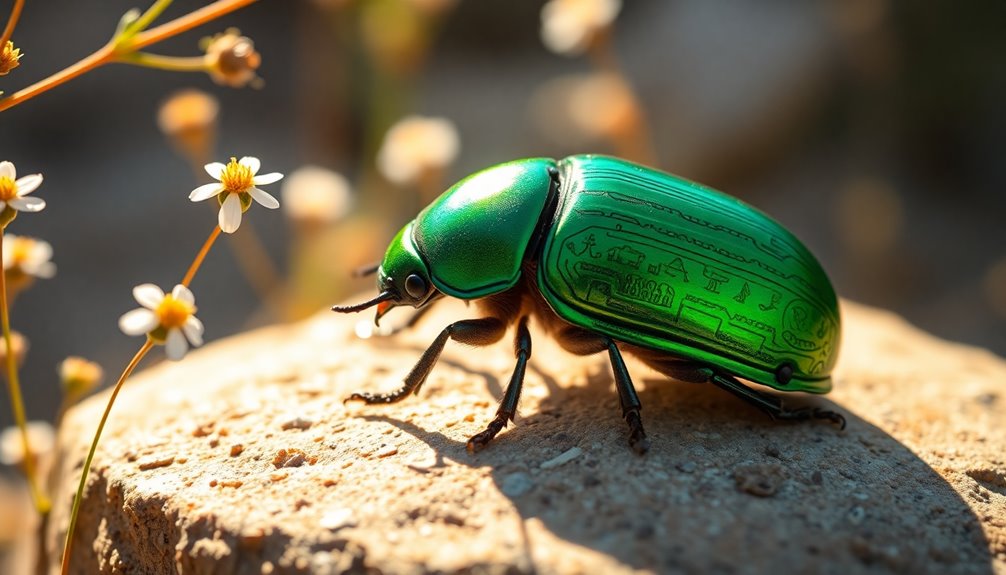
While many symbols in ancient Egyptian culture represent various aspects of life and death, scarab beetles stand out for their profound association with immortality and protection. You'll find that these sacred scarabs embody the essence of renewal and rebirth, symbolizing eternal life. Their ability to reproduce without a mate inspired the belief in their connection to the afterlife, reinforcing their role as guardians of the deceased.
Imagine:
- A heart scarab, carefully placed on the heart during mummification, ensuring protection in the judgment before Osiris.
- Scarab amulets adorning mummies, safeguarding souls in their journey to the afterlife.
- Jewelry featuring scarabs, warding off evil spirits and promoting good luck for the living.
In Egyptian mythology, scarab beetles were closely linked to the sun god Ra, who transformed into a scarab at night, symbolizing resurrection. This connection emphasizes not just their role in funerary practices but also the broader significance of protection.
Transformation and Personal Growth
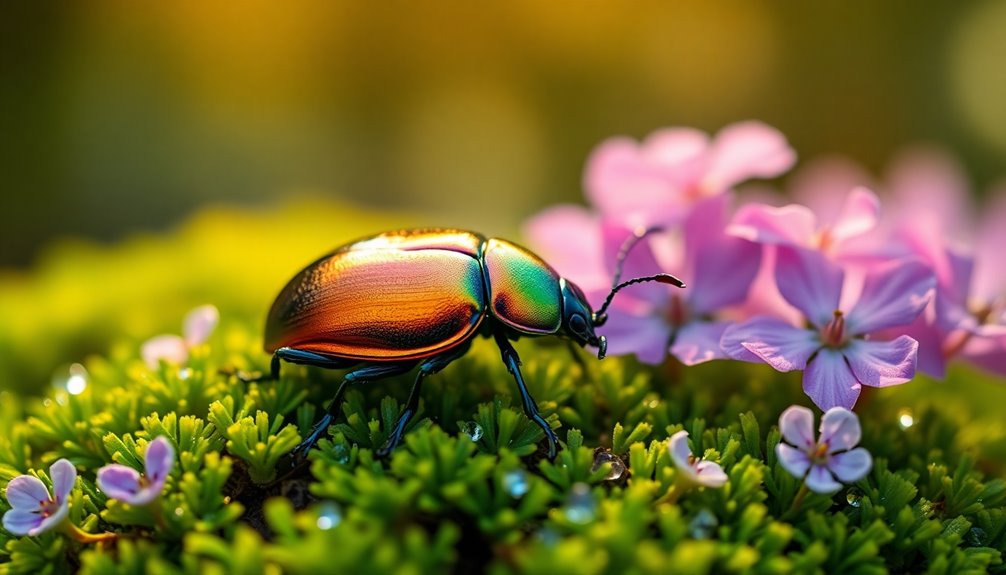
The scarab beetle's symbolism extends beyond immortality and protection, inviting you to explore the profound aspects of transformation and personal growth. The life cycle of scarab beetles—transitioning from egg to larva, then to pupa and adult—mirrors your journey through challenges and changes.
In ancient Egyptian culture, these beetles represented rebirth and renewal, urging you to embrace change as a pathway to personal evolution. Scarab amulets, often placed on mummies, highlight the importance of transformation in both life and death. They served as spiritual guides, facilitating the deceased's journey to the afterlife, and they remind you of the strength you possess to navigate your own life cycle.
As you encounter or dream of scarab beetles, let them serve as powerful reminders to tap into your inner strength. This connection to the sun god Khepri emphasizes daily renewal, encouraging you to reinvent yourself continuously.
Embracing these transformative aspects of your experiences can lead to significant personal growth. The scarab beetle teaches you that every ending is merely the beginning of a new chapter, filled with opportunities for renewal and rebirth.
Frequently Asked Questions
What Does the Scarab Beetle Symbolize Spiritually?
The scarab beetle symbolizes transformation, rebirth, and protection spiritually.
It reminds you of the cycles of life and the potential for personal growth. When you encounter this symbol, think of it as a guide through challenges, encouraging you to embrace change.
Its connection to immortality and good fortune can inspire you to seek renewal in your own journey, helping you overcome obstacles and attract positive energy into your life.
What Is the Power of the Scarab Beetle?
The power of the scarab beetle lies in its ability to symbolize transformation and resilience.
When you embrace its energy, you can tap into your own potential for growth and renewal. This ancient symbol encourages you to overcome challenges and reflect on your personal journey.
Which God Is the Egyptian Scarab Beetle Associated With?
The Egyptian scarab beetle is primarily associated with the god Khepri.
You'll find Khepri depicted as a scarab or a man with a scarab head, symbolizing the rising sun and renewal.
His actions of rolling the sun across the sky mirror the beetle's behavior of rolling dung balls.
This connection emphasizes the scarab's significance in representing life, death, and rebirth, making it a powerful symbol in ancient Egyptian mythology.
What Does the Beetle Symbolize Spiritually?
The beetle symbolizes transformation and rebirth, encouraging you to embrace change in your life.
It reminds you of your inner strength and resilience, guiding you through shifts. You can see the beetle as a powerful emblem of personal growth, reflecting your journey through challenges.
Additionally, it's associated with good luck and abundance, inviting positive change and spiritual protection.
Conclusion
As you embrace the scarab beetle's spiritual meaning, remember the ancient Egyptians who revered it as a symbol of rebirth. Just like the sun rises each day, you too can harness this powerful energy for transformation and personal growth. Let the scarab guide you, protecting your journey through life's trials and tribulations. By releasing this ancient power within, you're not just surviving; you're thriving, embodying the everlasting spirit of renewal that the scarab represents.

